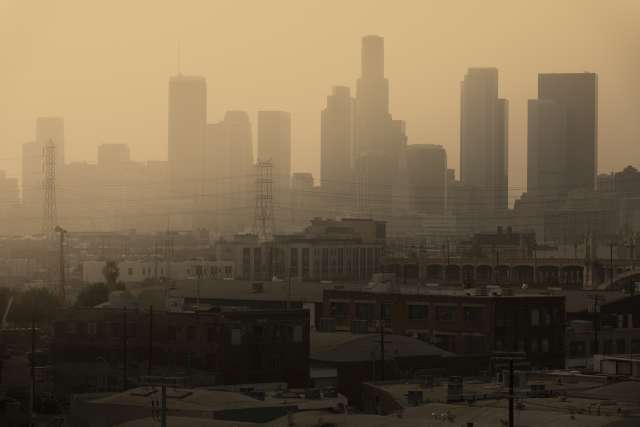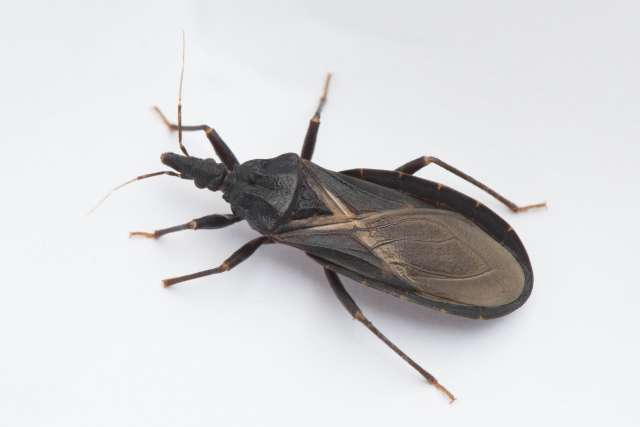The fires may no longer be raging, but their impact on our health and communities continues.
“This is our Hurricane Katrina – an epochal disaster that’s changing Los Angeles,” said David Eisenman, MD, whose research focuses on public health and disasters. “The fire transformed everything: our air, soil, landscapes and institutions.”
Dr. Eisenman, a professor-in-residence at the David Geffen School of Medicine at UCLA, was among a slate of experts discussing the public health and environmental fallout from the Los Angeles fires at a Jan. 28 presentation by the UCLA Fielding School of Public Health.
More than 55,000 acres of land burned in the recent fires – larger than the size of Washington, D.C.
“We are only beginning to understand the magnitude of loss and its public health impact,” said Ron Brookmeyer, PhD, dean of the UCLA Fielding School of Public Health, who hosted the presentation.
The event addressed air quality, safe post-fire cleanup, disaster preparedness and mental health effects related to the fires. Here are some key takeaways:
Air quality: The fires impacted air quality across the region, even many miles away from the fires in Altadena and Pacific Palisades. Fine particulate matter, called PM2.5, are the most concerning pollutants driven by wildfires, said Yifang Zhu, PhD, a professor of environmental health sciences who studies air pollution and climate change. These ultrafine particles can be inhaled deep into the lungs and cause a range of health problems, she said.
The air quality index (AQI) measured by the Environmental Protection Agency reflects the level of PM2.5 particles in the air. However, even when AQI numbers look good, gas-based pollutants known as volatile organic compounds (VOCs) may still be present. VOCs are what cause that smoky smell in the air, she said. These gaseous molecules are easily dispersed by wind, but when winds are weak, VOCs can remain in the air, even when particle concentrations are low, Dr. Zhu said.
“If you can smell smoke, it means you are being exposed and should take precautions,” she said.
When air quality is poor, it’s important to stay inside with doors and windows closed. Filter indoor air with your heating, ventilation and air-conditioning system, or use an air purifier. Avoid smoking, burning candles or frying food without proper ventilation, Dr. Zhu said, as these things can also increase exposure to PM2.5 and VOCs (though not on the level of wildfires).
If you must be outdoors, wear an N95 mask, but keep in mind that these masks don’t protect against VOCs, she added.
Air pollution from wildfires affect human health through three major pathways, said Michael Jerrett, PhD, the Jonathan Fielding Chair in Climate Change and Public Health.
It can interfere with signaling from the autonomic nervous system to the cardiovascular system, potentially dysregulating heart rate. This can lead to increased risk of atrial fibrillation and heart attacks, he said.
It can cause inflammation in the lungs that spills over into other organ systems, including the heart and the brain. And inhaling very small particles can bypass the body’s natural defenses, going directly into the bloodstream where, he said, they can “threaten every organ system in the body.”
Studies show that pregnant people exposed to more days of wildfire smoke were more likely to have adverse pre-term birth outcomes than those exposed to fewer smoky days.
“That is a concern with these fires we've just experienced,” Dr. Jerrett said, “that we could begin to see more adverse birth outcomes.”
Dr. Jerrett was a co-author of a study published in 2024 that found that more than 50,000 deaths were attributable to California wildfire pollution between 2008 and 2018. Another study found that wildfire exposure led to an increase in incident dementia.
“Society is likely underinvesting in wildfire prevention and response,” he said. “We really need to step up now that we’ve seen the absolute devastation experienced in Los Angeles.”
Post-fire cleanup: People returning to homes in burn areas should wear N95 masks, gloves and booties as they search through rubble or clean away damage and debris – and only after first responders have screened the area for hazardous materials such as lithium batteries from electric cars and propane tanks from backyard barbecues, which can spark fires.
“You’re going into what is still currently considered a hazardous waste zone, so you have to take proper precautions,” Dr. Jerrett said.
The Los Angeles County Department of Public Health can provide a personal protective equipment kit that includes gloves, booties, a protective bodysuit and a respirator, said Rachael Jones, PhD, chair of the department of environmental health sciences at the UCLA Fielding School of Public Health.
“Take that equipment off before you get back in your car, so that you don’t bring that contamination home,” she said.
If your home is still standing in a burn area and you see evidence that smoke has penetrated the home – brown or black lines along windows and floorboards, things that look like spider webs in corners – it’s a good idea to have a registered industrial hygienist evaluate the property, Dr. Jerrett said. A registered industrial hygienist is someone trained in environmental measurement who can take samples of airborne contaminants and recommend remediation actions.
In homes with significant smoke damage, carpet, furniture, drywall and insulation will need to be removed, he said. In homes with less smoke penetration, an industrial steam cleaner can be used to clean carpets and furniture and soap and water can be used on non-porous surfaces.
Cleanup itself can spread pollution within the burn areas, said Miriam Marlier, PhD, an assistant professor of global environmental change. Ultrafine particles and other toxic pollutants can be kicked up into the atmosphere as debris is hauled away. The hauling, too, by diesel trucks also creates air pollution, Dr. Jerrett added.
Mental health: Many Angelenos, even those not directly impacted by the fires, are mourning the loss of beloved landscapes.
“There’s a word for this: solastalgia – meaning the loss of solace and distress caused by environmental damage,” Dr. Eisenman said. “Though the landscapes will regenerate, until then their loss compounds our grief.”
The fires are a “collective trauma,” said Dana Rose Garfin, PhD, a psychologist and associate professor-in-residence in the department of community health sciences at the UCLA Fielding School of Public Health. Los Angeles residents have been impacted directly and indirectly, physically and mentally, she said. Research correlates these impacts with post-traumatic stress disorder, anxiety, depression, increased substance use and difficulty functioning in work, school and social relationships.
Exposure to media coverage of the fires is another stressor, Dr. Garfin said, that has affected individuals across the city and beyond.
Many people can expect to experience psychological distress because of the fires that will dissipate over time, she said. For some people, however, symptoms may persist and even worsen in the months to come.
Dr. Eisenman recommends seeing a primary care physician for symptoms such as trouble sleeping, heart palpitations and sadness that last for more than a few weeks.
To protect mental health, aim to reestablish routines with work, school and recreation to the extent you’re able, even if you and your family have been displaced, Dr. Garfin said, adding that routines are especially important for children. Even kids who were not directly or indirectly impacted by the fires could experience distress from seeing fire coverage on the news. She suggested minimizing consumption of media coverage of the fires and watching the news as a family to answer children’s questions and provide reassurance of their safety.
Connecting with loved ones and making time for relaxation, play and spirituality also helps reduce stress, Dr. Garfin said. Taking action to protect yourself and your family against future events can also help reduce psychological distress and provide a sense of control, she added.
Disaster preparedness: “This disaster demands that our communities change our approach to disaster preparedness,” Dr. Eisenman said. “Preparedness for fires must become higher priority.”
Evacuation plans and routes can be established ahead of the next disaster, Dr. Marlier said, and strategies put in place for potential flooding and erosion in burn areas.
Los Angeles needs a centralized, authoritative source to communicate about evacuation plans and environmental safety during disasters, Dr. Eisenman said: “We need to distill and preserve the great, practical advice coming from town halls and websites and pre-package them into easily distributed explainers.”
For instance, residents interested in knowing about air quality in their neighborhood, when they can return home or if they can go into the ocean – county public health officials issued an ocean water closure on Jan. 27 because of fire debris runoff – must check multiple websites to glean this information, he said.
“It takes a very sophisticated resident to figure that out,” Dr. Eisenman said. “So it’s just not a system that works for us in disasters.”
He also advocated for the development of community recovery programs that wed psychology and forest management to promote psychological recovery by helping individuals regain their connection to the land.




